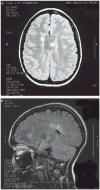Multiple sclerosis and acute disseminated encephalomyelitis diagnosed in children after long-term follow-up: comparison of presenting features
- PMID: 19018840
- PMCID: PMC2704249
- DOI: 10.1111/j.1469-8749.2008.03136.x
Multiple sclerosis and acute disseminated encephalomyelitis diagnosed in children after long-term follow-up: comparison of presenting features
Abstract
The aim of this study was to compare the characteristics of the first demyelinating event between acute disseminated encephalomyelitis (ADEM) and multiple sclerosis (MS). Children with acute demyelinating disease of the central nervous system and an abnormal brain magnetic resonance image (MRI) were studied. Patients were assigned a final diagnosis after long-term follow-up. Comparisons were made between the MS and ADEM groups. Proposed definitions by the Pediatric MS Study Group were applied to our cohort in retrospect and are discussed. Fifty-two children and adolescents with a documented abnormal brain MRI were identified (24 females, 28 males; mean age 10y 11mo [SD 5y 4mo] range 1y 10mo-19y 7mo). To date, 26 children have been diagnosed with MS, and 24 with ADEM. One child has relapsing neuromyelitis optica and one child has clinically isolated optic neuritis. Follow-up duration was 6 years 8 months in monophasic patients, and 5 years 6 months in relapsing patients. None of the patients with MS had encephalopathy while encephalopathy was present in 42% of patients with ADEM. Cerebrospinal fluid oligoclonal bands, an elevated immunoglobulin and the periventricular perpendicular ovoid lesions correlated with MS outcome. Several clinical characteristics differ between ADEM and MS at first presentation; encephalopathy, when present, strongly suggests the diagnosis of ADEM.
Figures


Similar articles
-
Acute disseminated encephalomyelitis, multiphasic disseminated encephalomyelitis and multiple sclerosis in children.Brain. 2000 Dec;123 Pt 12:2407-22. doi: 10.1093/brain/123.12.2407. Brain. 2000. PMID: 11099444 Clinical Trial.
-
Comparison of deep gray matter lesions on magnetic resonance imaging among adults with acute disseminated encephalomyelitis, multiple sclerosis, and neuromyelitis optica.Mult Scler. 2014 Apr;20(4):418-23. doi: 10.1177/1352458513499420. Epub 2013 Jul 25. Mult Scler. 2014. PMID: 23886831
-
Acute disseminated encephalomyelitis.Handb Clin Neurol. 2013;112:1253-62. doi: 10.1016/B978-0-444-52910-7.00048-9. Handb Clin Neurol. 2013. PMID: 23622336 Free PMC article. Review.
-
Acute disseminated encephalomyelitis: a follow-up study of 40 adult patients.Neurology. 2001 May 22;56(10):1313-8. doi: 10.1212/wnl.56.10.1313. Neurology. 2001. PMID: 11376180
-
Pediatric central nervous system inflammatory demyelination: acute disseminated encephalomyelitis, clinically isolated syndromes, neuromyelitis optica, and multiple sclerosis.Curr Opin Neurol. 2009 Jun;22(3):233-40. doi: 10.1097/wco.0b013e32832b4c47. Curr Opin Neurol. 2009. PMID: 19434783 Review.
Cited by
-
Paediatric clinically isolated syndromes: report of seven cases, differential diagnosis and literature review.Childs Nerv Syst. 2016 Jan;32(1):69-77. doi: 10.1007/s00381-015-2959-0. Epub 2015 Nov 19. Childs Nerv Syst. 2016. PMID: 26584554 Review.
-
The magnetic resonance imaging appearance of monophasic acute disseminated encephalomyelitis: an update post application of the 2007 consensus criteria.Neuroimaging Clin N Am. 2013 May;23(2):245-66. doi: 10.1016/j.nic.2012.12.005. Epub 2013 Feb 26. Neuroimaging Clin N Am. 2013. PMID: 23608688 Free PMC article. Review.
-
[Inflammatory diseases of the central nervous system].Radiologe. 2021 Jun;61(6):575-585. doi: 10.1007/s00117-021-00863-x. Epub 2021 Jun 8. Radiologe. 2021. PMID: 34105011 German.
-
Acute onset blindness: a case of optic neuritis and review of childhood optic neuritis.BMJ Case Rep. 2016 Oct 4;2016:bcr2016214929. doi: 10.1136/bcr-2016-214929. BMJ Case Rep. 2016. PMID: 27702928 Free PMC article. Review.
-
Pediatric multiple sclerosis.Nat Rev Neurol. 2009 Nov;5(11):621-31. doi: 10.1038/nrneurol.2009.158. Epub 2009 Oct 13. Nat Rev Neurol. 2009. PMID: 19826402 Review.
References
-
- Dale RC, de Sousa C, Chong WK, Cox TC, Harding B, Neville BG. Acute disseminated encephalomyelitis, multiphasic disseminated encephalomyelitis, and multiple sclerosis in children. Brain. 2000;123:2407–22. - PubMed
-
- Tenembaum S, Chamoles N, Fejerman N. Acute disseminated encephalomyelitis: a long-term follow-up study of 84 pediatric patients. Neurology. 2002;59:1224–31. - PubMed
-
- Krupp LB, Banwell B, Tenembaum S International pediatric Multiple Sclerosis Study Group. Consensus definitions proposed for pediatric multiple sclerosis and related definitions. Neurology. 2007;68(16 Suppl 2):S7–S12. - PubMed
-
- McDonald WI, Compston A, Edan G, Goodkin D, Hartung HP, Lublin FD, et al. Recommended diagnostic criteria for multiple sclerosis: guidelines from the International Panel on the diagnosis of multiple sclerosis. Ann Neurol. 2001;50:121–27. - PubMed
-
- Traboulsee AL, Li DK. The role of MRI in the diagnosis of multiple sclerosis. Adv Neurol. 2006;98:125–46. - PubMed
Publication types
MeSH terms
Grants and funding
LinkOut - more resources
Full Text Sources
Medical

